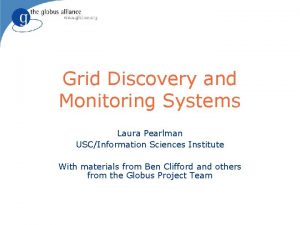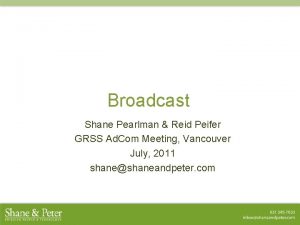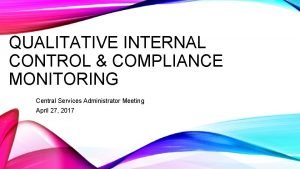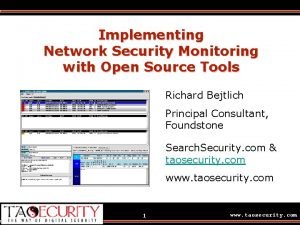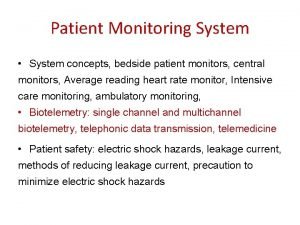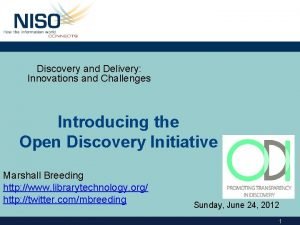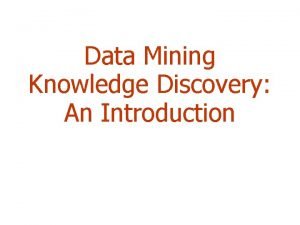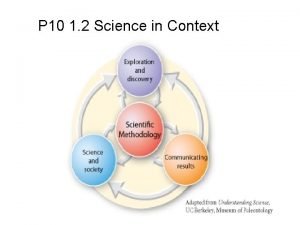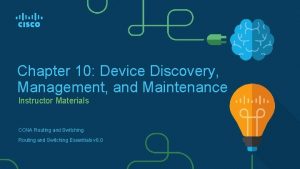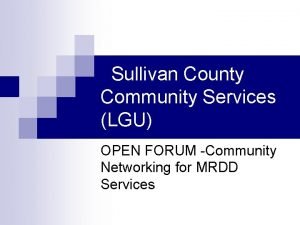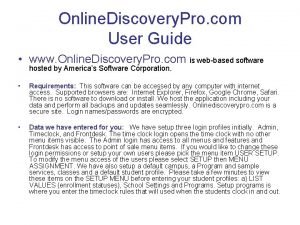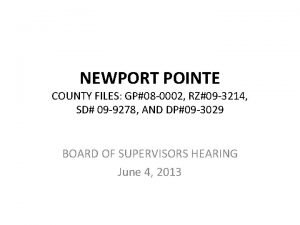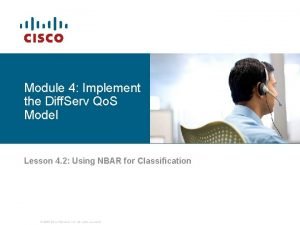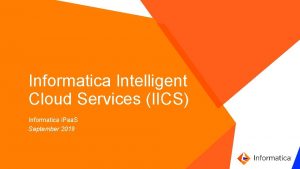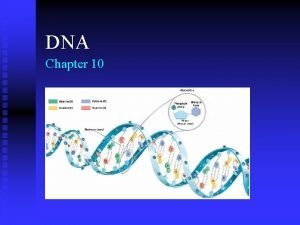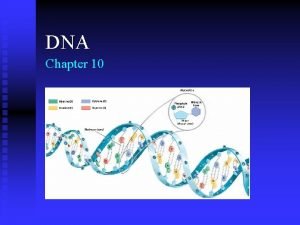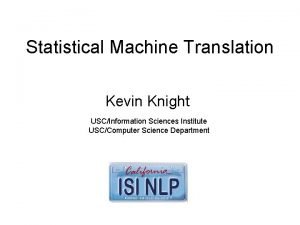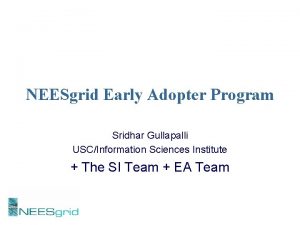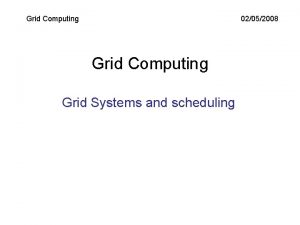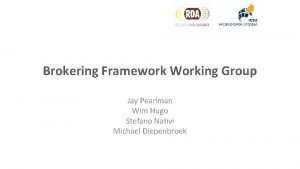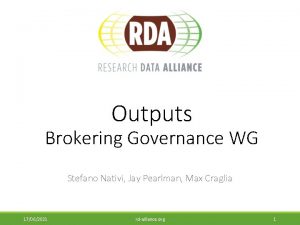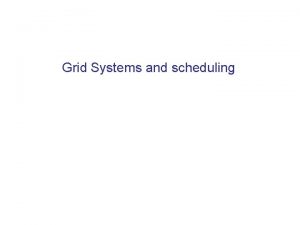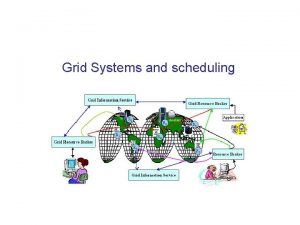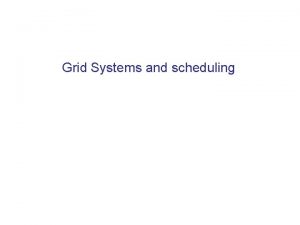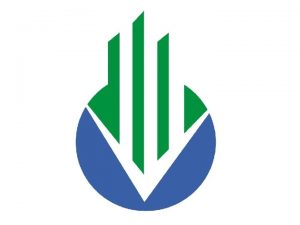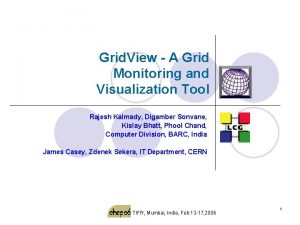Grid Discovery and Monitoring Systems Laura Pearlman USCInformation



















































- Slides: 51

Grid Discovery and Monitoring Systems Laura Pearlman USC/Information Sciences Institute With materials from Ben Clifford and others from the Globus Project Team

Outline l Overview of information systems l Some real implementations u Globus MDS 2 / BDII u Globus MDS 4 u Inca u GMA / R-GMA

Discovery and Monitoring l Discovery: finding resources that exist, at any moment, possibly meeting some criteria u l Monitoring: determining the state of one or more resources u l E. g. , “find linux boxes with Java 1. 5 installed” E. g. , “how much memory is free on machine X”? “Monitoring” and “Discovery” information sometimes overlap u “find me machines with 2 G memory” vs. “how much memory does Machine X have”

Examples of Useful Information l Characteristics of a compute resource u. Software available, networks connected to, load, type of CPU, disk space l Characteristics u. Bandwidth l Information u. Contact of a network and latency, protocols about a service info, version number, etc.

Who uses this information? l Individual users, trying to pick the ‘best’ resource l Brokers or workflow systems trying to find suitable resources l VO administrators who want to know the state of every resource. u System administrators may use this information, but probably also have local site monitoring systems in place

What Interfaces are Needed? l Graphic and command-line interfaces for individual users and administrators l Programmatic interfaces for brokers, workflow systems, etc. l Asynchronous notifications for administrators u “send me mail when we’re almost out of disk space”

Monitoring/Discovery Problems in Grids l Dynamic in nature u VOs come and go u Resources join and leave VOs u Resources change status and fail l Geographically distributed users l Geographically distributed resources l Heterogeneous implementations

Grid Information: Facts of Life l Information l Distributed is always old state hard to obtain l Components u. We will fail must deal with this gracefully l Scalability l Many and overhead different usage scenarios

Resource Discovery/Monitoring R R R ? R R dispersed users R R R ? network ? R R R R ? VO-A l Distributed users and resources l Variable resource status l Variable grouping R R R VO-B R

Resource Discovery/Monitoring R R R ? R R dispersed users R R R ? network ? R R R R ? VO-A l Some resources have failed l A network partition has occurred l Still, some work can get done… R R R VO-B R

Scalability l Large numbers Many resources u Many users u l Independence Resources shouldn’t affect one another u VOs shouldn’t affect one another u l Graceful degradation of service “As much function as possible” u Tolerate partitions, prune failures u

Failure Scenarios l User is disconnected l Resource fails or is disconnected l Discovery service fails or is disconnected l Network partition

When a user is disconnected l This should not adversely affect other users l Some state (such as the user’s subscriptions) may need to be cleaned up. l Some systems use soft-state to deal with this issue: u u Subscriptions are valid for a limited time and must be periodically refreshed If the user does not come back in time to refresh the subscription, it will be removed automatically.

When a resource disappears l Monitoring services should indicate that the resource is no longer there l Discovery services should stop advertising the resource l Neither of these can be gauranteed to happen instantaneously.

When a discovery service dies l Users cannot discover new resources. l They may have old information cached – this data is still useful, although it degrates in quality/usefulness. l Users can contact the resources directly and determine their status. l Some implementations allow for mirroring of discovery services.

When the network is partitioned l This could be seen as a generalization of some the previous scenarios – all of the previous scenarios can be modelled as appropriate network partitions. l If there is a discovery service in a user’s partition, the user should be able to discover resources in that partition.

Information Systems l We sometimes refer to Discovery and Monitoring as “Information Systems” u l This is misleading, as we’re not including general-purpose database systems Discovery and Monitoring information is: u Often stale as soon as it’s reported u Sometimes inconsistent u Often updated by running probes, either ondemand or periodically

Discovery Services l l Used to locate monitoring services with information about resources. May cache some resource data u l Generally involve a database-like query interface u l May even cache enough resource data to act as a monitoring system. Languages like ldap, xpath, sql Usually a relatively small number (maybe even just one, or one with a mirror) are deployed in a VO.

Two Models for Discovery Services Discovery Service Monitoring Service Monitoring & Discovery Service

Monitoring Services l Used to monitor the state of a resource l Service interface usually involves db-like queries l u With languages like ldap, xpath, sql u Often also provides for asynchronous notification Typically also includes a back-end provider interface u l Allows locally-written scripts, programs, etc. to collect information for the monitoring service Typically deployed on each host that houses a resource.

How Different Implementations Differ l Overall architecture u l Wire protocol u l l LDAP, Web Services, custom Query Language u l Are monitoring and discovery separate? LDAP, Xpath, SQL Caching Strategies Schemas u Really more a deployment issue

MDS 2 / BDII history l MDS 2 was developed as part of the Globus Toolkit u l It’s now superseded by MDS 4, which has a different architecture. BDII is a reimplementation of MDS 2 by EGEE, and is still in use.

MDS 2 Architecture Overview l The Grid Resource Information Service (GRIS) collects information about a local resource and responds to requests for that information u Uses pluggable information providers l The Grid Index Information Service (GIIS) aggregates information from various GRIS servers l Users may query the GIIS for aggregated information or query the GRIS servers directly. l GIIS servers may be arranged hierarchically.

MDS 2 Architecture GIIS GRIS IP IP

MDS 2 GIIS l Grid Index Information Service (GIIS) servers aggregate information from GRIS servers and other GIIS servers. u u l l These other servers register themselves to the GIIS server. Registrations must be periodically refreshed GIIS servers cache information (results from previous queries). If a GIIS server receives a query for which there is no fresh cached information, it forwards the query to its registered servers.

MDS 2 GRIS l A Grid Resource Information Server (GRIS): u u Runs on each host that has resources to be monitored. Accepts requests for information about local resources l u Runs a local “information provider” to collect and format the information l u May come from users or GIIS servers Unless the requested information is cached and relatively fresh Caches the information and replies to the request

MDS 2 Query Language l Both the GIIS and GRIS servers use LDAP as the service protocol and query language.

LDAP Basics l l l Hierarchical data model Each entry has a distinguished name and a set of attribute/value pairs Distinguished name u u u Is a collection of name-value pairs Must be unique Determines the entry’s place in the hierarchy l l Each entry’s DN must include its parent’s DN Queries u u Can search on attributes or DNs Results can include children (or not) or include only certain attributes.

MDS 4 Overview l l MDS 4 is a redesign of MDS The MDS 4 Index Service acts as both a monitoring and discovery service. u l A second monitoring service, the MDS 4 Trigger Service, examines aggregated information and takes action when certain conditions are met. u l Uses WSRF standard resource property queries as its query interface. E. g. , “send email when a remote system appears to be down”. MDS 4 uses WSRF standards for its query and registration interfaces.

WS-Resource Review l A WS-Resource is a Web Service that exposes internal state as Resource Properties u l Each WS-Resource has a Resource Property Document u l An XML element of arbitrary complexity An XML document that includes all its Resource Properties Example: The WS-GRAM service advertises information about its associated queues and clusters as a resource property.

Retrieving Resource Properties l Get. Resource. Property u l Get. Multiple. Resource. Properties u l Gets a set of named resource properties Query. Resource. Property u l Gets a single named resource property Returns the results of a query against a resource’s resource property set Subscription/notification u Clients subscribe and get periodic or occasional notifications

What this means… l l Standard requests can be used to get state information from any WS-Resource. This means that every WS-Resource is also a monitoring service! u l But not necessarily monitoring anything (i. e. , providing any interesting state) We sometimes want information from sources other than WS Resources u u u Non-WSRF services General system information Catalogues of installed software

Service Groups Review l l A service group is a service that represents a group of other services or resources Service groups contain Service Group Entries (SGEs), which consist of: u u u l The address of the SGE itself, The address of the Service Group that the SGE belongs to, and A Content element consisting of arbitrarily-formatted data SGEs are created via the Service Group Add request

The MDS 4 Index Service l Acts as a Discovery Service u u l Gathers information from other WSResources Including other Index Servers Acts as a Monitoring Service u u Caches all the information it gathers Also has a pluggable interface for Information Providers l Programs or Java classes that gather information

An MDS 4 Index Deployment Index GRAM Index RFT IP IP

The MDS 4 Index Data Model l The Index Service keeps its data as a Service Group u l Registering a new resource to be monitored is accomplished by adding a service group entry to the service group. The data in each SGE contains both: u Configuration information l u E. g. , “query the X resource property from server Y” and the actual collected data.

Index Data Model (simplified) Index Service Group SGE SG EPR SGE EPR Content Config Get. RP RP EPR Data GLUECE Queue Name State Cluster Name OS

Data Model continued l l In the Index Service data model, data is grouped with its configuration information Can have the “same” data two different places in the tree, if it was acquired from two different information sources. u l E. g. , information about a host’s load average from two different GRAM servers running on that host. Relatively easy to find where each piece of data came from.

How the Index Updates its Data l Periodically, the Index Service examines each SGE in its Service Group l If the SGE’s registration has expired and not been renewed, it is destroyed. l Otherwise, the Index u u u l looks at the Config part of the SGE content, gathers data as specified by that config information, and updates the data in the Data part of the SGE content Data is updated periodically, not on demand.

Querying the Index Service l The Index Service advertises its service group as a resource property u u l You can fetch the whole thing with Get. RP or Get. Multiple. RPs Most people use Query. RP to query it. Query. RP allows you to specify a dialect and a query u Currently, only Xpath is supported as a dialect

XPath Queries l Search an XML document and return some subset of the XML entities. l If an entity is included in the results, it’s included in its entirety u Unlike LDAP, no way to leave out attributes or children

MDS 4 Trigger Service l A second monitoring service in MDS 4 l The Index is geared more towards queries intended for resource location and selection. l The Trigger service is intended to alert people to problems. u Can be configured to take action (e. g. , send mail to an administrator) when issues arise.

MDS 4 Trigger Service l l Maintains information in a service group, like the Index Service SGE config information also includes an xpath query and an action u l The action is the name of a program to run. Periodically, the trigger service looks at each SGE in its servicegroup: u u It evaluates the SGE’s xpath query against the SGE’s data. If the query returns true, it runs the program specified by the action.

MDS 4 Web. MDS l Provides a simple HTTP interface to query an MDS Index Service u l l Really, to query resource properties of any WS-Resource Optionally applies XSLT transforms to the query results. Designed as a user interface, to be used with a web browser u But some people are using it to provide a REST-like interface to MDS 4.

INCA l l l Monitoring system developed at SDSC Users define tests for Inca to run. Inca runs them and stores the results in a database. Users can view the results on a web page. Can be configured to send mail if tests fail, etc. Can run tests using the user’s credentials

From the Inca 2. 1 User’s Guide, http: //inca. sdsc. edu/releases/2. 1/guide/userguide. html

Inca Query Interface l Uses an SQL database internally l End-users can query using a web page or receive notifications via email. l A web-services interface is also available u Uses a custom query language l Overall a nice monitoring/testing framework l Not designed as a discovery service

GMA (Grid Monitoring Architecture) l Proposed architecture with three components: u Producers produce information u Consumers consume information u Directories keep track of what information is available l what producers can be queried, not the actual data Diagram from “A Grid Monitoring Architecture”, B. Tierney et al. , http: //wwwdidc. lbl. gov/GGF-PERF/GMA-WG/papers/GWD-GP-16 -2. pdf

R-GMA l Relational Grid Monitoring Architecture l Implements the GMA model u u l Except that users never interact with the directory service (called a “registry” in RGMA) A consumer service does that instead, and users query the consumer service. Uses SQL as its query language.

An R-GMA Query • Client sends SQL query to Consumer Service • Consumer Service contacts registry for list of producers to contact • Consumer service queries producers and buffers results • Client retrieves results from consumer service Diagram from “R-GMA: Architectural Design” at http: //www. r-gma. org/archconsumers. html

For More Information l Globus: http: //www. globus. org l Inca: http: //inca. sdsc. edu l R-GMA: http: //www. r-gma. org l XML / Xpath / XSLT: http: //www. w 3 c. org
 Dr laura pearlman
Dr laura pearlman Shane pearlman
Shane pearlman Indica el reflexivo reciproco adecuado
Indica el reflexivo reciproco adecuado Pga vs lga
Pga vs lga Compliance monitoring kalispell
Compliance monitoring kalispell Nsm network security monitoring open systems
Nsm network security monitoring open systems Reservoir monitoring system
Reservoir monitoring system Bedside patient monitoring system
Bedside patient monitoring system Condoplex monitoring systems
Condoplex monitoring systems Compliance opacity monitoring
Compliance opacity monitoring Decision support systems and intelligent systems
Decision support systems and intelligent systems Engineering elegant systems: theory of systems engineering
Engineering elegant systems: theory of systems engineering Embedded systems vs cyber physical systems
Embedded systems vs cyber physical systems Elegant systems
Elegant systems Chapter 7 section 1 cell discovery and theory
Chapter 7 section 1 cell discovery and theory Discovery and action dialogue
Discovery and action dialogue Chapter 7 section 1 cell discovery and theory
Chapter 7 section 1 cell discovery and theory Information discovery and delivery
Information discovery and delivery Introduction to data mining and knowledge discovery
Introduction to data mining and knowledge discovery Exploration and discovery where ideas come from
Exploration and discovery where ideas come from Section 1 cell discovery and theory
Section 1 cell discovery and theory Exploration and discovery
Exploration and discovery Difference between invention and discovery
Difference between invention and discovery Pros and cons of discovery learning
Pros and cons of discovery learning Price discovery and price determination
Price discovery and price determination Section 1 cell discovery and theory
Section 1 cell discovery and theory Device discovery management and maintenance
Device discovery management and maintenance Picme2.0
Picme2.0 Allusions about love
Allusions about love Federated discovery
Federated discovery Salem witch trials discovery education
Salem witch trials discovery education 7 habits of highly effective teens habit 5
7 habits of highly effective teens habit 5 Center for discovery sullivan county
Center for discovery sullivan county Requirements discovery techniques in software engineering
Requirements discovery techniques in software engineering Becquerel discovery of radioactivity
Becquerel discovery of radioactivity Online discovery pro
Online discovery pro Newport pointe discovery bay
Newport pointe discovery bay Naviance self discovery
Naviance self discovery Nature reviews drug discovery
Nature reviews drug discovery Show ip nbar protocol-discovery
Show ip nbar protocol-discovery Smart data discovery
Smart data discovery When did joseph lister make his discovery
When did joseph lister make his discovery Genre of a separate peace
Genre of a separate peace What is iics
What is iics Discovery of golgi apparatus
Discovery of golgi apparatus Discovery of golgi apparatus
Discovery of golgi apparatus Gamma rays discovered
Gamma rays discovered Discoveryftp
Discoveryftp Mistakes are the portals of discovery essay
Mistakes are the portals of discovery essay Entrepreneurial discovery definition
Entrepreneurial discovery definition Section 10-1 review discovery of dna
Section 10-1 review discovery of dna Section 10-1 discovery of dna
Section 10-1 discovery of dna
